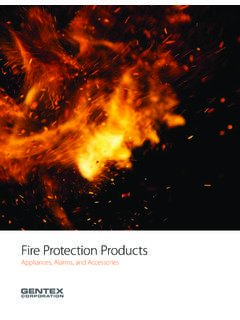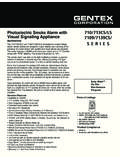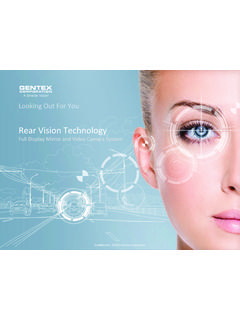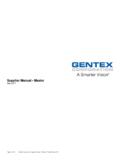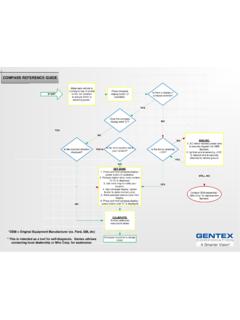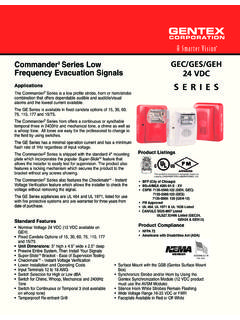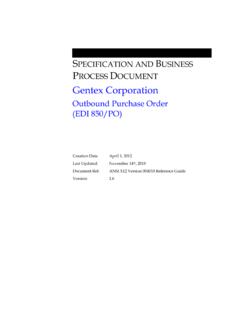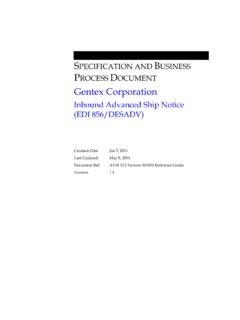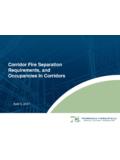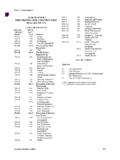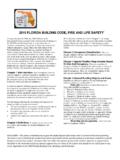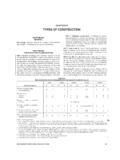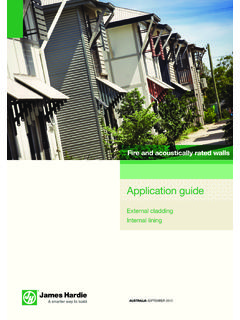Transcription of The Fire Alarm Requirements
1 $ fire Alarm RequirementsNFPA 72 & 101 ANSI CorporationFire Protection Products Group10985 Chicago , MI 494641-800-436-83911-800-436-8392 (fax)As one of Gentex s programs to help educate our partners in business, wewish to introduce to you some of the basic fire Alarm Requirements of theNational fire Protection Association, the American National Standards Institute,and the Americans with Disabilities Act which pertain to audible and visiblealarms and how they relate to fire Alarm of the difficulties and challenges this industry and you will face is thevarying installation and performance Requirements for life safety and Requirements vary from state to state based on which specific code is ineffect (NFPA, UFC, UBC, SFPC, BOCA, SBCCI, etc.) and to the actual revisiondates of the adopted code. When you couple this with the provision of the ADAand the fire Safety Act it can be very varying codes/standards and laws make it extremely difficult to specify,install, and manufacture fire Alarm products, not to mention enforce the latestrequirements of our national standards or federal laws with any degree did we get in such a predicament?
2 In Quick Summary:! In 1992 President Bush signed legislation that was called the Americanswith Disabilities Act. (ADAAG)" Enacted to provide equal accessibility to all individuals. There was specific reference made to light intensity of visual signals ( ),audible alarms and manual pull the advent of the Americans with Disabilities Act in 1992, issuesregarding fire Alarm systems began to unfold. For example:! In the provisions of ADAAG indicated that strobe lights be installedwith the following characteristics:" The lamp shall be a XENON strobe type or equivalent." The color shall be clear or nominal white." The maximum pulse duration shall be 2/10 of a second." The intensity shall be a minimum of 75 Candela." The flash rate shall be a minimum of 1HZ and a maximum of 3HZ." In general, no place in any room or space required to have a visual signal shall bemore than 50 feet from the new provisions represented quite the departure from what we as anindustry had become accustomed to and had been installing for years.
3 Itcreated, among other things, a great deal of controversy and confusion in thefire Alarm industry, among building owners, AHJ's, etc., simply because of thechanges and the fact that the ADAAG Requirements are not enforceable byAHJ s.! Remember, prior to the ADA the industry had been utilizing NFPA 72G(Notification Appliances for Protective Signaling Systems).! The old standard (72G) was very generic and perhaps cumbersome incomparison to the Requirements of the ADA ( ).For example, NFPA 72G Direct Primary Appliance Photometrics and Primary Appliances Photometrics were the standards we were utilizing.! Under Direct Primary Appliances we noted that:" where the average illuminance is less than 5 lumens per square foot# you installed a strobe of to 15 Candela.! Direct Primary Appliances where the" average illuminance was greater than 5 lumens per square foot# you installed a strobe rated between 15 Candela and 150 Candela.
4 " average illuminance was greater than 20 lumens per square foot# you installed a strobe rated between 100 Candela and 1000 Candela.! Indirect primary appliance photometrics was even more difficult tounderstand and implement. Here the standard read:" should be type and intensity and located to alert persons." average illuminance of the pulsing signal at a standard nominal work plane 30inches above the floor should be 1/10th the steady state, work plane where did this leave us as an industry? Conflict. Huge Conflicts! Notonly conflict, but alas, visual signals which were much more intense inoutput and drawing a lot more current that we were accustomed.! ADA (1992)!NFPA 72G - 1989" 75 Candela".015 to 1000 Candela" 80" or 6" below ceiling, or"a minimum 80" from floor6" from ceiling whichever"one appliance per is lessroom, one additional "50' from signalfor every 7500 square "1-3 HZ flash ratefeet - maximum separation 100' "1/3 - 3 HZ flash rateAn important note as we move into the future is: we as an industry did not utilizethe Requirements under indirect primary appliance photometrics even thoughthe new Requirements of UL 1971 are based on indirect viewing!
5 Go back andreview NFPA 72G .. reflecting light, walls, etc. The same principal as the passage of the Americans with Disabilities Act in 1992 we have seenmany changes in our codes and standards, whether it be at the state, local ornational 72G Became NFPA 72 Chapter 6! Notification Appliances for fire Alarm Systems" Where we as an industry started to be more specific on spacing requirementsand Candela ratings based on actual room example, through the research conducted by Underwriters Laboratoriesduring its development of UL 1971, spacing Requirements were born:NFPA 72 Table (a)Room spacing allocation for wall mount visible appliancesMaximum Required Light Output, Candela (Cd)(Effective Intensity)MaximumRoom SizeOne LightPer RoomTwo Lights Per Room(Located on OppositeWalls)Four Lights Per Room (One Light Per Wall) 20 x 20 30 x 30 40 x 40 50 x 50 60 x 60 70 x 70 80 x 80 90 x 90 100 x 100 110 x 110 120 x 120 130 x 130 15306095135185240305375455540635N/A15306 09595135185240240305375N/AN/AN/AN/AN/AN/ A609595135135185 Table (b)Room spacing allocation for ceiling mounted visible appliancesMaximum Room SizeMinimum Required Light Output, Candela (Cd)(Effective Intensity)Maximum Ceiling HeightOne Light (Cd)
6 20' x 20'10'1530' x 30'10'3040' x 40'10'6050' x 50'10'9520' x 20'20' 3030' x 30'20' 4540' x 40'20' 8050' x 50'20'11520' x 20'30' 5530' x 30'30' 7540' x 40'30'11550' x 50'30'150 Notes: When ceiling heights exceed 30 feet visible signals shall be suspended at or below 30 foot level or wallmounted. Table (above) is based on locating the visible in center of room. Where it is not centered, theeffective intensity (Cd) shall be determined by doubling the distance from the appliance to thefarthest wall to obtain maximum room Note: ANSI = No reference is made to ceiling spacing allocation for wall mounted visible Length (ft)Min. # of 15 Cd Visible Appliances Required0-30131-1302131-2303231-3304331- 4305431-5306 Table intensity Requirements for sleeping areaVisible Notification ApplianceDistance from ceiling to top of lensIntensityGreater than or equal to 24"110 CandelaLess than 24"177 CandelaReferring to the above table ( ) from NFPA 72 Chapter 6 it isinteresting to note that the original ADA Requirements themselves were notspecific on light intensity in sleeping areas.
7 It simply referred to 75 , in a later technical bulletin dated July 1992, they specificallyreferenced the UL research calling for 110 Cd or 177 Cd to awaken thehearing reviewing the provisions in NFPA 72 Chapter 6 in comparison withADA ( ) Requirements we see the following glaring differences:! ADA was based on 75 Cd regardless of room size (50'x50').! No more than 50' from signal.! Flash rate of 1-3Hz versus 1/3-3Hz.! Mounting heights this did was to lead the industry to expand on the Requirements found inthe ADAAG Requirements under 2-2 Equivalent , under the Requirements stated in 2-2 Equivalent Facilitation, using otherdesigns and technologies are permitted where the alternative designs andtechnologies used provide substantially equivalent or greater access to andusability of the facility. Taking the Candela Requirements of the ADA of 75 Candela divided by thedistance (50') squared = 2500 square feet, we noted that the averageilluminance increase per square foot was.
8 The same formula in the smaller areas as found in UL 1971 and NFPA72 we can see that 15 Cd (NFPA, UL 1971)(20' x 20') divided by the roomsquared equals .0375 lumens per square , ADA s requirement for 75 Cd in a 50' x 50' area produces .030 lumensper square foot increase in illuminationcompared to15 Cd in a 20' x 20' area produces .0375 lumens per square foot , utilizing a visible signal less than 75 Candela in a smaller room isequivalent to a larger Candela strobe in a larger room; by providing greaterilluminance per square foot. (. )With the new confusing Requirements of ADAAG, coupled with the fact theAHJ s could not legally enforce the Requirements , new NFPA requirementscalling for something completely different than what ADAAG was calling for a new star was born: 15/75 Candela products.! 15 Candela listed to UL 1971.
9 " The new UL standard for hearing impaired.! 75 Candela to meet the Requirements of ADA without invoking anyinterpretations under 2-2 Equivalent Facilitation." ADA did not reference any specific UL listing standard. Research utilizedto develop ADA Requirements was based on UL 1638 where does this leave us today?What is coming in the revisions of ADA, ANSI and NFPA 72?! It appears we are heading toward somewhat uniform requirementsbetween all of the codes, standards and ! Visible notification appliances shall be installed in accordance with (a) using one of the following:" Use a single visible notification appliance." Two visible notification appliances located on opposite walls." In rooms 80' x 80' or greater, where there are more than 2 visibles in any field ofview, they shall be spaced a minimum of 55' from each other.
10 " More than 2 visible notification appliances that flash in synchronization." Xenon Strobe or Equivalent." Clear or Nominal White." Flash rate 1Hz minimum and 2Hz maximum over its rated voltage " Pulse duration 2/10 of 1 second." Dispersion-comply with table (a) for wall mounting. (b) for ceiling mounting." Mounting Height - 80" minimum to 96" maximum, measured to the bottomof appliance." Ceiling Mounted Appliances located in accordance with " Spacing and Minimum Intensity." Multiple appliances are permitted only where shape, size, and buildingconstruction prohibit total coverage by a single appliance." Where multiple appliances are provided in a single area to provide total areacoverage, the appliances shall comply with one of the following:# Maximum of 2 appliances located on opposite walls.
